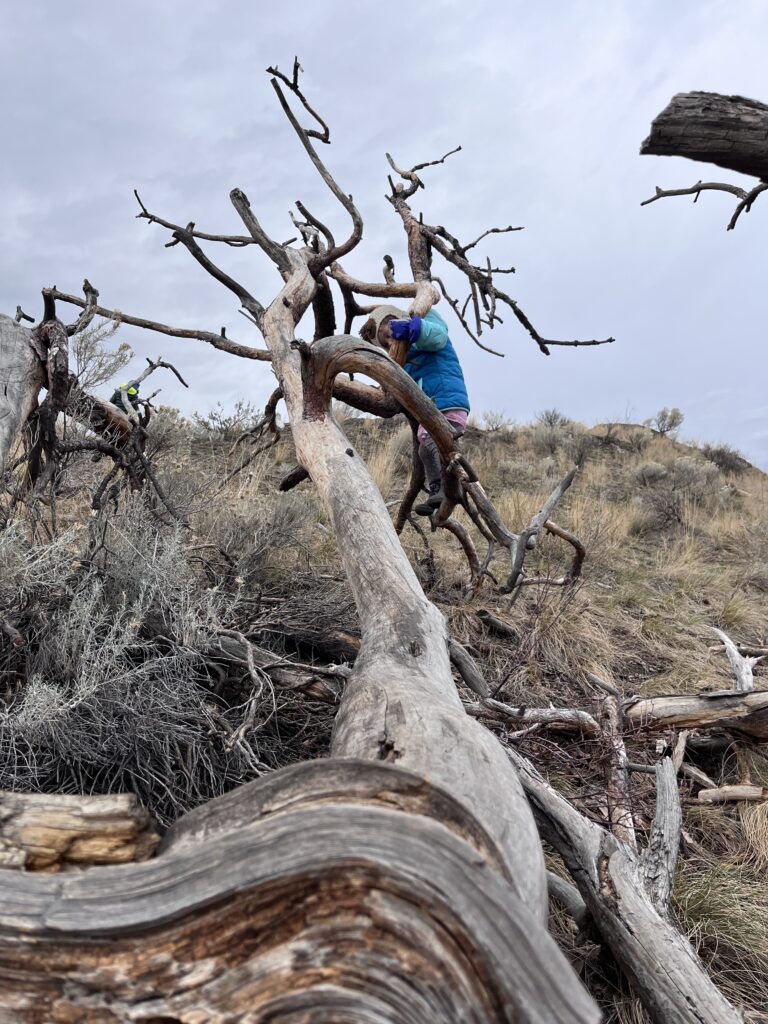Throughout my practicum in the Willows room, the Pirate Ship Tree, also known as “Pirate Tree” with the children. On this page I will be showing my work with the pirate ship tree and the documentation I have taken throughout my time with it.
October 3, 2024: “We’re going to the pirate ship!” -L , L and M were chanting “PIRATE SHIP” on the walk but unfortunately we were not heading to the tree that day so L asked the question “why aren’t we going to the pirate ship today?” and we were able to let them know we will be going the next day. Even though we didn’t go to the Pirate Ship Tree on this day it became obvious that the Willows were very excited for the next time we would go.

October 4, 2024: On the walk to the tree Z yelled “pirate tree!!” and A sang “were going on an adventure! Can’t see daycare” . A talked about the water we saw and that’s when “I see the pirate tree!” -A and “The pirate tree!!!” -F. G picked up a large log that fell off the tree and said “this looks like a sword”. While leaving the tree everyone yelled and waved “bye Pirate Tree!”



October 11, 2024: “We’re going to the pirate tree!”-F singing in to the tune of the bear hunt book, “The big hill is stronger than the pirate tree” -D as he pointed towards the hill above our tree, “I can see a rocket ship!” “Hello!!” -G as she sat on top of the tree, “Ivy I’m way up here!” -A, “I’m up here too!” -F, “wee woo” -Z pretending the pirate ship tree is an ambulance


October 17, 2024: Today the children decided to go to the pirate ship tree themselves, they all wanted to climb and do their big body movements. “Hey Ivy look!” -I as she pointed at the pirate tree, “I can do it!” -G as she was climbing the tall branches, “I’m playing my carrot” -Z he sang as he trimmed a stick, “It’s a hotdog carrot” -Z, “We have to dig!” -J as he and a friend were digging near the tree
October 30, 2024: The hole in the tree was an interesting curiosity today, we looked at how big it is, what was in it, what could fit in it, and what bugs we could see living in it. We learned that this portion of the tree was quite hollow and acted as a home to some tiny bugs.
November 13, 2024: Today I had a conversation with a few children that I found very interesting, it started out with the question what’s your favourite thing about the pirate tree. G said that she likes that “we get to play” and how we find rocks, “prickly pears that we don’t touch”, and sticks. This conversation them turned into a story with another child who said that “it fell from a big storm” and he made a lot sounds to explain how big the crash was when the tree fell, I then asked the children when this must have happened, “20 minutes ago!”-G “No! 60 minutes”. For me this conversation was very interesting, I enjoyed to see the story being created of the place we visit so often, the sense of belonging that the children were creating together and the connection to place.



Before I knew the Pirate Ship Tree I never would have known that this old and dead looking tree was a play space to the children of Cariboo. The most obvious thing that the tree does for the children is how it allows them to expand on their gross motor skills and confidence in their own abilities as they climbed higher up the tree. As I got to know the tree though it showed me that it is a natural playground that encourages curiosity, imagination, exploration, socialization, and belonging for the children. The pirate ship has been many different things, it has been a car, ambulance, a way to create music, a fishing boat, and so much more. The children have come to teach me their own stories of the tree, how something that is usually just a fallen tree can actually be much more important than you may think. Not only is the tree important but the area it’s can also be a learning experience for the children, for example the we got the chance to learn about prickly pears, the bugs that lived near and on the tree, and the different plants around the tree. With that the children have made the tree become an important place in their childhoods using the natural world as their way of learning rather than using the human-made toys and play structures.
While observing the other educators and interacting with the children while at the tree, it also taught me what it means to be an educator and how to become an educator throughout my practicum. It showed me that I need to trust the children in their abilities that they know they have and if I don’t feel comfortable with it than I shouldn’t stop what they’re doing but maybe just stand close as they’re trying out a new way around the tree. I learned that some children take more risks than others and that encouraging them, when they aren’t dangerous, is okay. I am so grateful for the opportunities I had to learn and grow with the children and the tree and I hope to continue learning about what more nature can do to teach the children in my care.





